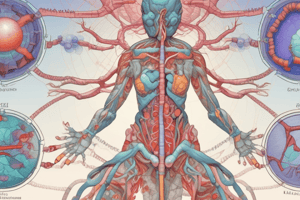Podcast
Questions and Answers
What is the primary mechanism by which glucocorticoids reduce inflammation?
What is the primary mechanism by which glucocorticoids reduce inflammation?
- By inhibiting the production of prostaglandins, leukotrienes, and interleukin-2. (correct)
- By directly neutralizing inflammatory mediators in the bloodstream.
- By stimulating the release of anti-inflammatory cytokines from immune cells.
- By promoting the synthesis of new anti-inflammatory proteins within the liver.
How do glucocorticoids affect blood glucose levels and insulin sensitivity?
How do glucocorticoids affect blood glucose levels and insulin sensitivity?
- They lower blood glucose by suppressing gluconeogenesis in the liver.
- They decrease blood glucose by enhancing insulin sensitivity in peripheral tissues.
- They have no significant impact on either blood glucose levels or insulin sensitivity.
- They increase blood glucose by promoting gluconeogenesis and inducing insulin resistance. (correct)
What is the role of the glucocorticoid-receptor complex once it enters the nucleus?
What is the role of the glucocorticoid-receptor complex once it enters the nucleus?
- To bind to glucocorticoid response elements (GRE) on chromatin, influencing gene transcription. (correct)
- To initiate the breakdown of nuclear DNA, leading to cell apoptosis.
- To modify the structure of the nuclear membrane, facilitating transport of molecules.
- To directly inhibit ribosome function and halt protein synthesis.
Why is hydrocortisone the preferred treatment for acute adrenal insufficiency?
Why is hydrocortisone the preferred treatment for acute adrenal insufficiency?
How do glucocorticoids affect neutrophil counts in the blood?
How do glucocorticoids affect neutrophil counts in the blood?
What is the rationale behind administering betamethasone to pregnant women facing premature delivery?
What is the rationale behind administering betamethasone to pregnant women facing premature delivery?
How does dexamethasone suppress ACTH secretion?
How does dexamethasone suppress ACTH secretion?
What is the primary indication for the overnight dexamethasone suppression test?
What is the primary indication for the overnight dexamethasone suppression test?
Why are 'stress doses' of glucocorticoids administered to individuals on long-term glucocorticoid therapy?
Why are 'stress doses' of glucocorticoids administered to individuals on long-term glucocorticoid therapy?
What is the most appropriate timing for administering physiologic replacement therapy for adrenal insufficiency?
What is the most appropriate timing for administering physiologic replacement therapy for adrenal insufficiency?
How does cortisol upregulate alpha1 adrenergic receptors in blood vessels?
How does cortisol upregulate alpha1 adrenergic receptors in blood vessels?
What is the primary reason glucocorticoids are used as adjuvant therapy in neoplastic conditions?
What is the primary reason glucocorticoids are used as adjuvant therapy in neoplastic conditions?
What distinguishes iatrogenic Cushing syndrome from Cushing syndrome caused by endogenous cortisol production?
What distinguishes iatrogenic Cushing syndrome from Cushing syndrome caused by endogenous cortisol production?
What is the rationale behind alternate-day therapy (ADT) with glucocorticoids?
What is the rationale behind alternate-day therapy (ADT) with glucocorticoids?
How does cortisol influence cellular metabolism by affecting peripheral adipose tissue and muscles?
How does cortisol influence cellular metabolism by affecting peripheral adipose tissue and muscles?
How does the mechanism of action of synthetic glucocorticoids differ from that of endogenous cortisol?
How does the mechanism of action of synthetic glucocorticoids differ from that of endogenous cortisol?
Which of the following glucocorticoids requires conversion in the liver to become active?
Which of the following glucocorticoids requires conversion in the liver to become active?
Which of the following duration-of-action classifications does Prednisone belong to?
Which of the following duration-of-action classifications does Prednisone belong to?
Which of the following glucocorticoids is considered to be the most potent?
Which of the following glucocorticoids is considered to be the most potent?
Which of the following autoimmune diseases is NOT treated with glucocorticoids?
Which of the following autoimmune diseases is NOT treated with glucocorticoids?
The following clinical conditions are all treated with glucocorticoids EXCEPT:
The following clinical conditions are all treated with glucocorticoids EXCEPT:
Which of the following best describes how glucocorticoids are used in treating hematopoietic cancers?
Which of the following best describes how glucocorticoids are used in treating hematopoietic cancers?
Which of the following conditions can commonly result from excessive cortisol?
Which of the following conditions can commonly result from excessive cortisol?
Which of the following is NOT a side effect of synthetic glucocorticoids?
Which of the following is NOT a side effect of synthetic glucocorticoids?
How do glucocorticoids affect bone metabolism?
How do glucocorticoids affect bone metabolism?
What are the primary hormones regulated by the hypothalamic-pituitary-adrenal (HPA) axis?
What are the primary hormones regulated by the hypothalamic-pituitary-adrenal (HPA) axis?
What is the effect of glucocorticoids on wound healing?
What is the effect of glucocorticoids on wound healing?
What are common musculoskeletal side effects associated with prolonged glucocorticoid use?
What are common musculoskeletal side effects associated with prolonged glucocorticoid use?
In the context of glucocorticoid therapy, what does 'demargination' refer to?
In the context of glucocorticoid therapy, what does 'demargination' refer to?
A patient on long term glucocorticoid therapy is scheduled for elective surgery. Which course of action would be most appropriate?
A patient on long term glucocorticoid therapy is scheduled for elective surgery. Which course of action would be most appropriate?
Flashcards
Glucocorticoids
Glucocorticoids
Steroid hormones secreted by the adrenal cortex, regulating immune response and metabolism.
CRH (Corticotropin Releasing Hormone)
CRH (Corticotropin Releasing Hormone)
Hormone secreted by the hypothalamus, stimulating the pituitary gland to release ACTH.
ACTH (Adrenocorticotropic Hormone)
ACTH (Adrenocorticotropic Hormone)
Hormone released by the anterior pituitary gland, acting on the adrenal cortex to release glucocorticoids.
Cortisol
Cortisol
Signup and view all the flashcards
Gluconeogenesis
Gluconeogenesis
Signup and view all the flashcards
Diabetogenic Effect
Diabetogenic Effect
Signup and view all the flashcards
Demargination
Demargination
Signup and view all the flashcards
Short-Acting Glucocorticoids
Short-Acting Glucocorticoids
Signup and view all the flashcards
Intermediate-Acting Glucocorticoids
Intermediate-Acting Glucocorticoids
Signup and view all the flashcards
Long-Acting Glucocorticoids
Long-Acting Glucocorticoids
Signup and view all the flashcards
Addison's Disease
Addison's Disease
Signup and view all the flashcards
Physiologic Replacement Therapy
Physiologic Replacement Therapy
Signup and view all the flashcards
Addisonian Crisis
Addisonian Crisis
Signup and view all the flashcards
Cushing Syndrome
Cushing Syndrome
Signup and view all the flashcards
Cushing Disease
Cushing Disease
Signup and view all the flashcards
Symptoms of Cushing Syndrome
Symptoms of Cushing Syndrome
Signup and view all the flashcards
Overnight Dexamethasone Suppression Test
Overnight Dexamethasone Suppression Test
Signup and view all the flashcards
Iatrogenic Cushing Syndrome
Iatrogenic Cushing Syndrome
Signup and view all the flashcards
Stress Doses
Stress Doses
Signup and view all the flashcards
Alternate-Day Therapy (ADT)
Alternate-Day Therapy (ADT)
Signup and view all the flashcards
Study Notes
- Glucocorticoids are steroid hormones secreted by the adrenal glands, which sit atop each kidney.
- The adrenal gland consists of two layers: the inner medulla and the outer cortex.
- The adrenal cortex secretes corticosteroid hormones, including glucocorticoids, under the control of adrenocorticotropic hormone (ACTH).
Regulation of Glucocorticoid Secretion
- The hypothalamus secretes corticotropin releasing hormone (CRH), which stimulates the anterior pituitary gland to secrete ACTH.
- ACTH travels to the adrenal glands and binds to ACTH receptors on adrenocortical cells.
- This binding causes adrenocortical cells to release glucocorticoids from the zona fasciculata.
- Glucocorticoids have anti-inflammatory and metabolic effects.
- Excess glucocorticoids exert a negative feedback effect on the hypothalamic-pituitary-adrenal axis, suppressing the release of CRH and ACTH.
Mechanism of Action
- Glucocorticoids enter the circulation and travel to target cells.
- As lipophilic molecules, they cross the cell membrane and bind with cytoplasmic glucocorticoid receptors.
- The glucocorticoid-receptor complex undergoes structural changes, allowing it to enter the nucleus and bind to glucocorticoid response elements (GRE) on chromatin.
- This binding induces transcription of specific mRNA, leading to the synthesis of proteins that modify cell functions and metabolic effects.
Cortisol
- Cortisol is the most important glucocorticoid in humans and is released during times of stress, such as illness or starvation.
- Cortisol regulates the immune response and cellular metabolism, including gluconeogenesis.
- It promotes an anti-inflammatory state by inhibiting prostaglandins, leukotrienes, and interleukin-2 production.
- Cortisol has catabolic effects on the body, triggering lipolysis in adipose tissue and proteolysis in muscles.
- The resulting free fatty acids and amino acids are substrates for gluconeogenesis in the liver.
- Cortisol increases insulin resistance in tissues, leading to elevated blood glucose levels, a diabetogenic effect.
- Cortisol maintains blood pressure by up-regulating alpha1 adrenergic receptors, causing vasoconstriction.
Synthetic Glucocorticoids
- Synthetic glucocorticoids produce similar effects to endogenous cortisol but also increase the number of neutrophils in the blood through demargination.
- Demargination is when neutrophils detach from the endothelial lining of blood vessels and enter the circulation.
- Synthetic glucocorticoids decrease lymphocyte, monocyte, basophil, and eosinophil counts.
Classification Based on Duration of Action
- Short-acting glucocorticoids: Duration of 8-12 hours; includes cortisone and hydrocortisone.
- Cortisone is taken orally and converted to hydrocortisone in the liver; inactive topically.
- Hydrocortisone is chemically identical to cortisol and can be taken orally, intravenously, or intramuscularly; drug of choice for acute adrenal insufficiency; also available topically.
- Intermediate-acting glucocorticoids: Duration of 12-36 hours; includes prednisone, prednisolone, methylprednisolone, and triamcinolone.
- Prednisone is taken orally.
- Prednisolone can be administered perorally, intravenously, and topically.
- Methylprednisolone can be administered orally, intravenously, intramuscularly, or intra-articularly.
- Triamcinolone can be administered orally, intramuscularly, topically, and intra-articularly.
- They are 4-5 times more potent than short-acting glucocorticoids.
- Long-acting glucocorticoids: Duration of 36-72 hours; includes betamethasone and dexamethasone.
- Can be taken orally or injected intravenously, intramuscularly, or intra-articularly.
- Dexamethasone can be used topically.
- These medications are 25 times more potent than short-acting glucocorticoids.
Clinical Uses of Glucocorticoids
- Treatment of adrenal conditions: Used in primary adrenal insufficiency (Addison disease) and congenital adrenal hyperplasia.
- Short-acting glucocorticoids are used as physiologic replacement therapy to mimic the normal diurnal pattern, with the largest dose in the morning and a smaller dose in the afternoon.
- Hydrocortisone is used to treat life-threatening adrenal crises due to its rapid effect.
- Anti-inflammatory/immunosuppressive therapy: Used in asthma, rheumatoid arthritis, Crohn's disease, ulcerative colitis, acute multiple sclerosis exacerbation, idiopathic thrombocytopenic purpura, eczema, allergic conjunctivitis, and rhinitis.
- Treatment of hypersensitivity states: Used in severe allergic reactions and to prevent graft-versus-host disease.
- Miscellaneous conditions: Used in chemotherapy-induced vomiting, hypercalcemia, and mountain sickness.
- Betamethasone can be given to pregnant women to speed up fetal lung maturation.
- Neoplastic conditions: Used as adjuvant therapy in hematopoietic cancers (acute lymphocytic leukemia, Hodgkin lymphoma, and non-Hodgkin lymphomas) due to their anti-lymphocytic effect.
- Dexamethasone is used to relieve cerebral edema in individuals with metastatic or primary brain tumors.
Dexamethasone Suppression Test
- Dexamethasone is a potent medication that can suppress the hypothalamic-pituitary-adrenal axis, even at low doses.
- Used in the overnight dexamethasone suppression test to diagnose Cushing syndrome.
- Cushing syndrome is caused by excessive cortisol production, either due to Cushing disease (pituitary adenoma overproducing ACTH) or other factors.
- Symptoms of Cushing's syndrome include obesity (buffalo hump, truncal obesity, moon facies), hyperglycemia, diabetes, muscle weakness, skin stretch marks, hypertension, osteoporosis, and increased risk of infections.
- In the test, a low dose of dexamethasone is administered to suppress ACTH production.
- Failure to suppress cortisol levels indicates Cushing syndrome.
Side Effects of Synthetic Glucocorticoids
- Rare when administered for physiologic replacement therapy but more common with high doses for prolonged periods.
- Iatrogenic Cushing syndrome: Side effects mimic those of Cushing syndrome and are more common than regular Cushing syndrome.
- Fluid and electrolyte disturbances: Fluid retention, hypertension, and hypokalemia.
- Endocrine side effects: Hyperglycemia, diabetes, and suppression of the hypothalamic-pituitary-adrenal axis, leading to adrenocortical atrophy.
- Immunosuppression: Increased risk of infection and impaired wound healing.
- Musculoskeletal side effects: Myopathy, avascular necrosis of femoral and humeral heads, osteoporosis, and pathological fractures.
- Psychiatric disturbances: Depression, insomnia, psychosis, and mood swings.
- Other side effects: Peptic ulcers and cataracts.
- Growth inhibition in children.
- Patients on long-term glucocorticoid therapy may require "stress doses" before or after surgery or during severe illness to prevent adrenal crisis.
- Alternate-day therapy (ADT) involves taking a doubled daily dose every other day to prevent suppression of the HPA axis and adrenocortical atrophy.
Studying That Suits You
Use AI to generate personalized quizzes and flashcards to suit your learning preferences.





